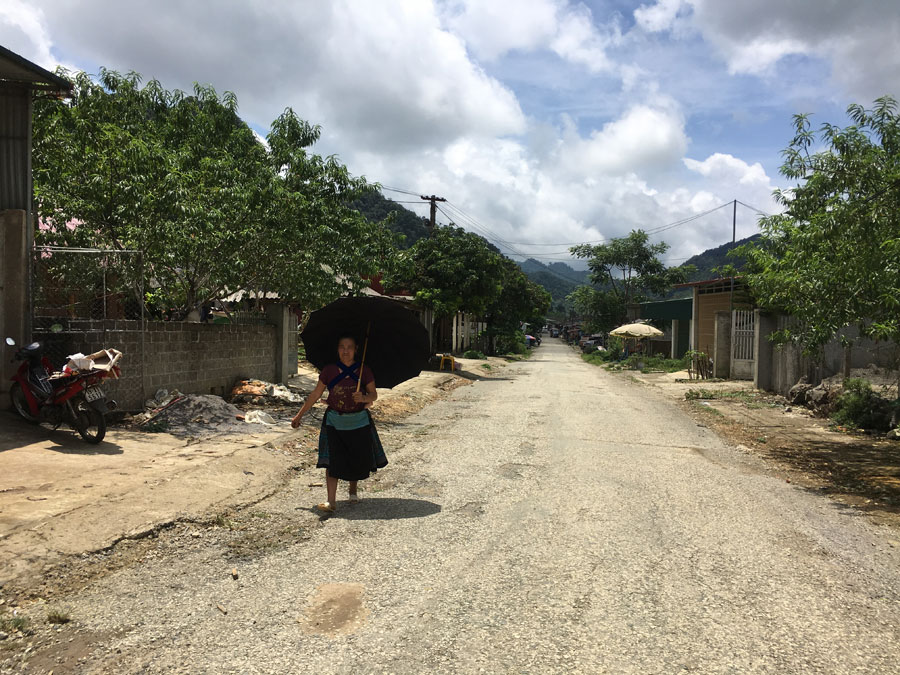
(HBO) - Together with maintaining cultural identities of Thai and Mong ethnic groups to develop tourism, Mai Chau district has paid attention to upgrading rural transport infrastructure. Despite a wide terrain and many hills, Mai Chau has a convenient rural road system which meets the travel demand of locals and contributes to welcoming investors to the tourism sector.

Pa Co commune’s roads have been invested and upgraded
to meet travel demand, thus contributing to developing community-based tourism
of the locality (Photo taken in Cha Day hamlet)
Anyone who comes to Mai Chau will be
impressed with the winding roads embracing mountainside villages. Inner-field
and inter-hamlet roads are spacious and clean, with colourful flowers on both sides,
creating a special attraction to tourists. According to statistics, the
district has 608.23 km of roads (excluding national highways and provincial
roads), of which there are 64.69 km of asphalt roads, 333.77 km of concrete roads,
14.29 km of macadam roads, and 195.47 km of dirt roads. The district has seven
communes meeting criterion No.2 in terms of transport in building new-style
rural areas, namely Tong Dau, Chieng Chau, Mai Ha, Van Mai, Mai Hich, Xam Khoe
and Pa Co. Four communes fulfilled three criteria, three communes meet two
criteria and one commune meets one criterion.
The district People's Committee has
directed authorised agencies and People's Committees of communes to mobilise
resources from local people and businesses to implement the project of concreting
rural roads during 2017 - 2020. Up to now, the district has completed and opened
to traffic 10.49 km of 45 roads, while construction is underway on 0.7 km of 2
roads. The total investment is more than 5.4 billion VND, of which more than
3.2 billion VND came from the provincial budget, and over 2.2 billion VND from
the district budget.
The district has paid attention to
implementing disaster prevention and control and ensuring traffic safety, while
focusing on installing danger warning boards at landslide-risk areas and
bridges. The district maintains the implementation of the campaign "All people engage
in upgrading rural transport” in April and November to carry out the maintenance
and repair of rural roads. In 2020, locals have contributed over 115,000
workdays to construct rural roads./.
A diverse chain of eco-tourism and resort destinations concentrated in Hoa Binh city and the districts of Tan Lac, Da Bac, and Luong Son… Along with the launch of several key high-quality resort tourism projects, these developments have reshaped the landscape and enhanced the appeal of Hoa Binh as a travel destination.
Boasting diverse terrain, a mild climate, and rich natural resources, Cao Phong district is increasingly asserting its place on Vietnam’s tourism map, attracting both domestic and foreign visitors. The district is renowned for its stunning landscapes, majestic mountains, a crystal-clear hydropower lake, and the unique cultural identity of local ethnic groups.
With its pristine landscapes, unique cultural heritage of Muong ethnic minority, and an expanding range of visitor experiences, Tan Lac district of Hoa Binh has fast become a captivating destination for both domestic and international tourists.
Until now, Sung village in Cao Son commune, Da Bac district remains the only Dao ethnic community in Hoa Binh province to develop a community-based tourism model. Beyond its untouched natural landscapes, cultural identity serves as the cornerstone attraction for visitors.
Alongside the diverse cultural identities of the Kinh, Muong, Tay, Thai, Dao, and Mong ethnic people, Hoa Binh province is also renowned as the "capital" of the northwestern Vietnamese cuisine, offering unique and distinctive dishes. At festivals, during Lunar New Year (Tet), or on significant family or community occasions, special dishes are prepared, leaving a lasting impression on visitors.
A Phong Linh (Yellow Tabebuia) flower garden in Thang village, Thach Yen commune, Cao Phong district is currently in full bloom, drawing a large number of visitors.



